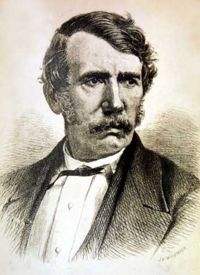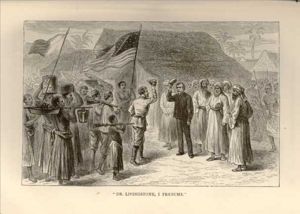David Livingstone
 From Conservapedia
From Conservapedia 
Dr. David Livingstone (1813-1873) was a Scottish missionary, doctor, and explorer. He is best known for his work in exploring central Africa, spreading Christianity, and fighting the slave trade. Some recognize him as the greatest of all African missionaries, explorers, and antislavery advocates. Livingston's work in Africa opened up an estimated one million square miles of previously uncharted land. He also searched for the source of the Nile.
Contents
- 1 History
- 1.1 Early life
- 1.2 1845-1862
- 1.3 1862-1873
- 2 Impact
- 3 Trivia
- 4 See also
- 5 References
History[edit]
Early life[edit]
Livingstone was born into a poor family living in Blantyre, Scotland in 1813. He had three brothers and one sister which were crowded into a two-room house. While in school at age ten, he worked at a local cotton mill fourteen hours a day. At a young age Livingstone became fascinated with medical science and theology, He studied both of these areas and graduated from the University of Glasgow, in 1838, with a degree in theology and medicine. After college Livingstone traveled to London to train for missionary work. He tried to travel to China as a missionary in 1838, but the Opium War in China blocked his access. The Missionary Society in London hesitated to sponsor Livingstone because they did not believe that his speaking style was polished enough. Livingstone soon met Robert Moffat, a missionary to Cape Town, Africa. While attending one of Moffat’s lectures Livingstone was struck by Moffats accounts of Africa. When speaking of Africa Moffat stated that, “I have sometimes seen, in the morning sun, the smoke of a thousand villages, where no missionary has ever been.[1]” It was at this time that Livingstone decided to go to Africa. In 1841, Livingstone traveled to with Moffat back to his missionary base to help with his mission work. Livingstone began his work in Africa quickly; in 1842 he started a four-year campaign to find the route to upper Zambezi River, his work here helped the Europeans commerce, which he believed instrumental in bringing Christianity to the region. He also started to push north to places that had not been explored by Europeans before. Livingstone also spoke against the slavery being carried out on the continent. As Livingstone traveled he became convinced that his mission was to reach the people in the interior of Africa and introduce them to Christianity. He married Moffat’s daughter, Mary, in 1845 and then settled north in Kolobeng.
1845-1862[edit]
In 1843, Livingstone's left arm was rendered useless due to a lion attack. The next year Livingstone and a friend began an expedition to cross the Kalahri Desert to discover what later began known as Lake Ngami. The two explorers succeed and later in 1851 discovered the Zambezi River. Because of dangers of exploring, Livingstone sent his wife, and four kids, back to England. He set off again to discover more of central Africa. Because of the dangers that Livingstone had encountered, he was equipped with 27 men to do his exploring. As he traveled he calculated the latitude and longitude of his the area. He also used his scientific knowledge in measuring the temperatures of waters and elevation. Livingstone discovered ‘Victoria Falls”, which he named after the English queen in 1855. In his travels he became the first European to travel the distance across southern Africa. He returned to Brittan, and Glasgow, Scotland, here he spent six months talking before the Royal Society, the Royal Geography Society,and the College of Physicians. 1856, he wrote a book documenting his discoveries entitled, ‘Missionary Travels and Researches in South Africa' the book sold over 70,000 copies and was a best seller.[2]
In November 1857 he published his missionary travels, a book which thoroughly reflects the man and is delightful reading. A second edition was called for before the first of twelve thousand copies was issued, and the generous conduct of John Murray, the publisher, made the work a small fortune for Livingstone, who spent most of the money on exploration. [3]
Livingstone returned to Africa in 1858, this time along with his missions work he carried out explorations in central Africa (including Lakes Mweru and Bangweulu). In addition to his wife’s death of malaria in 1862, Livingstone was having a hard time in his exploration. At one point some European members of his exploration had a fight and nearly mutinied.[4]
1862-1873[edit]
| Dr. Livingstone, I presume? — Henry Stanley |

He returned to home, in 1864, and began publishing material on the horrors of the slave trade. After returning to Africa in 1865, Livingstone set out on a personal obsession of his, finding the source of the Nile River. During his time exploring his correspondence with Europe was cut short and word spread that he had died. It was later found out that his crew had deserted him, and lied about his death. An American Newsman for the New York Herald, Henry Stanley, was later sent out to find Livingston. Some historians think that the motivation for Stanley’s search was to find Livingstone to pursue fortune. After eight months of searching Stanley finally found Livingstone. The two explored Lake Tanganyika together, then Stanley returned and filed a report of his exploration. Stanley came to Africa as an atheist but was converted to Christianity. He recalled his experience with Livingstone, “It was not Livingstone’s preaching that converted me, it was Livingstone’s living”. During Livingstone time exploring he had gotten ill, Stanley left him with supplies when he returned to America. Although Livingstone was offered to travel back to Europe, he refused stating, "Death alone will put a stop to my efforts!".[5] In April 1873, Livingstone wrote, “I am pale bloodless, and weak from bleeding profusely ever since the 31st of March last, an artery gives off a copious stream, and takes away my strength.[6]” On April 27, 1873 Livingstone died while praying. Livingstone heart was buried in Africa under a mvula tree, the rest of his body was buried in Westminster Abbey, on April 18, 1874, after being shipped back to England by the HMS Vulture. In 1913, the Royal Geographical Society held a meeting to commemorate Livingstone, they stated,
| “ | "In the course of his wonderful career, Livingstone served three masters. As a missionary he was the sincere and zealous servant of God. As an explorer he was the indefatigable servant of science. As the denouncer of the slave trade he was the fiery servant of humanity".[7] | ” |
Impact[edit]
Livingstone life work as a missionary, explorer, and advocate against slavery had huge impacts on both Europe and Africa. In 1893, Britain established its first colony in Africa, the British Central Africa Protectorate (today known as the Republic of Malawi), Livingstone’s work was instrumental in this effort. He added to European knowledge of African geography about one million square miles, and his maps and information was used to help bring the Bible to Africans. The effects of this can be seen today. As of 1990, in ten modern African countries in which Livingstone traveled, with a combined population of 140 million (125 million of that African-born), 75 million are Christians.[8] Livingstone efforts fighting the slave trade later help lead to its abolishment.[9] Livingston’s father in law, Robert Moffat, stated after Livingstone’s death, “He Sacrificed everything-home, Christian intercourse, lucrative prospects, and earthly honors, for one grand object, to carry the Gospel of the Son of God to the heart of Africa."[10]
Trivia[edit]
- Livingstone traveled over 40,000 miles over a thirty-two year period
- Livingstone’s son fought in the civil war [11]
- The day Livingstone died was declared a day of national mourning in the British Isles
- Robert Moffet, Livingstone's father in-law, lived longer than Livingstone
- Over 100 books have been written about Livingstone
- The Pallbearers for Livingstone's funeral were Thomas Steele, now Sir Tomas Steele, two friends of Livingston, Jacob Wright, a transporter of Livingstone’s body, Robert Moffet, and Henry Stanley.
- Livingstone was given the longest funeral procession in history, the procession covered over 1000 miles.
- One of the most popular phase related to Dr. Livingstone was said by Henry Stanley, after he had found Livingstone, he stated, “Dr. Livingstone, I presume.”
See also[edit]
- Albert Schweitzer
- David Brainerd
References[edit]
- ↑ Believers Web, "David Livingstone," http://www.believersweb.org/view.cfm?ID=74
- ↑ BBC, Historic Figures, https://www.bbc.co.uk/history/historic_figures/livingstone_david.shtml
- ↑ Dr David Livingstone - Scottish Missionary and explorer
- ↑ Wendy Kahler, Essortment, 2002, “David Livingstone”, http://iaia.essortment.com/drlivingstone_rnli.htm
- ↑ http://www.wholesomewords.org/missions/bliving10.html
- ↑ Sam Wellman, Heroes of the Faith, “David Livingston”, Barbour Publishing, pg. 200
- ↑ Janet and Geoff Benge, Christian Heroes: Then & Now, “David Livingston,”pg. 214
- ↑ Sam Wellman, Heroes of the Faith, “David Livingston”, Barbour Publishing, pg. 204
- ↑ Believers Web, “David Livingstone,” http://www.believersweb.org/view.cfm?ID=74
- ↑ Sam Wellman, Heroes of the Faith, “David Livingston”, Barbour Publishing, pg. 203
- ↑ Wendy Kahler, Essortment, 2002, “David Livingstone”, http://iaia.essortment.com/drlivingstone_rnli.htm
| |||||
Categories: [Missionaries]
↧ Download as ZWI file | Last modified: 02/14/2023 01:31:03 | 10 views
☰ Source: https://www.conservapedia.com/David_Livingstone | License: CC BY-SA 3.0
 ZWI signed:
ZWI signed: KSF
KSF